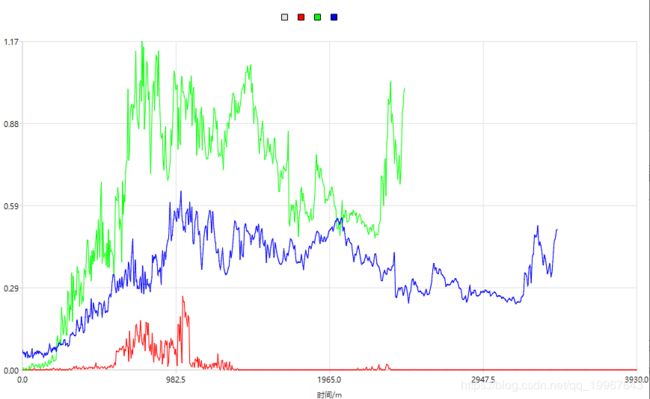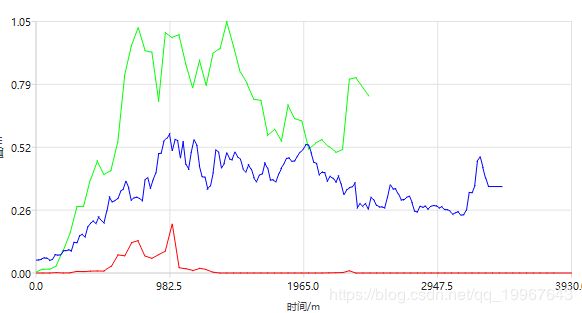C++ 曲线平滑
最近需要将数据通过图表展示出来,以便观察其变化趋势。直接展示出来的效果不是很好,故在网上查找了很久曲线平滑的方法,最终找到了了一套比较适合的方法,思路比较简单,对于现在的项目来说效果也还不错,故记录一下。
原始数据大小分别为881、490和1711,直接展示如下图所示:
由于采集过程中传感器数据变化比较敏感,所以有比较明显的锯齿,故第一步需要去差值。这里采用的是“五点去差值法”,即选周围五个点,去掉最大值和最小值求剩余三个点的平均,使其相邻点变得平滑。这里作了SIZE/20次去差值,去差值后如下图所示:
经过多次反复去差值后,可以看到曲线明显变得平滑了许多,也没有明显的锯齿了。但是我们只关心曲线的大致趋势,不需要那么多细节。由于前面已经将曲线相邻点变得比较平滑了,故下一步就直接减少点的数量,这里将数据量减少了十倍,减少数据量后效果如下:
去差值+减少数据量后看起来比原始数据展示好看多了,更加简洁明了。但是还是比较生硬,需要对其平滑一下。这里采用也是最简单的“线性五点平滑”法,选取周围五点点的数据取均值。这里做了20次平滑,平滑后的效果如下:
下面是完整代码:
头文件:
#ifndef _CHART_WIDGET_H_
#define _CHART_WIDGET_H_
#include
#include
#include
#include
#include
#include
class ChartWidget : public QChartView
{
Q_OBJECT
public:
ChartWidget(QWidget *parent = 0);
~ChartWidget();
enum MMSmoothType
{
SMOOTH_NULL = -1,
//拟合SIZE/200次 数据量减少10倍 平滑处理20次
SMOOTH_200_10_20,
//拟合SIZE/200次 数据量减少10倍 平滑处理20次
SMOOTH_200_10_10,
//拟合SIZE/50次 数据量减少20倍 平滑处理20次
SMOOTH_50_20_20
};
void AddLineSeries(QString Name, QColor color, const QList &Datas, MMSmoothType SmoothType = SMOOTH_NULL);
void SetAxisXRange(float Min, float Max);
void SetAxisYRange(float Min, float Max);
void SetAxisXTitle(QString Title);
void SetAxisYTitle(QString Title);
void SetTitle(QString Title);
void SetLegendVisible(bool IsVisible);
void SetBackgroundColor(QColor color);
void ClearDatas();
private:
void InitChartData();
//线性五点拟合去差值 临近五个点去掉最大值和最小值取平均
QList LinearFitted5(const QList& Datas);
//线性五点平滑 临近五个点取平均
QList LinearSmooth5(const QList& Datas);
QList SmoothData(const QList& Datas, MMSmoothType SmoothType);
private:
QValueAxis* m_AxisX;
QValueAxis* m_AxisY;
double m_MinX;
double m_MinY;
double m_MaxX;
double m_MaxY;
bool m_HasData;
};
#endif //_CHART_WIDGET_H_
源文件:
#include "ChartWidget.h"
#pragma execution_character_set("utf-8")
ChartWidget::ChartWidget(QWidget *parent)
: QChartView(parent),
m_MinX(0),
m_MaxX(0),
m_MinY(0),
m_MaxY(0),
m_AxisX(new QValueAxis),//sin的X轴
m_AxisY(new QValueAxis),//sin的Y轴
m_HasData(false)
{
QChart* chart = this->chart();
QFont font;
font.setFamily("Microsoft Yahei");
font.setPixelSize(10);
m_AxisX->setTitleFont(font);
m_AxisX->setLabelsFont(font);
m_AxisX->setTitleText("时间/m");
//m_AxisX->setLabelFormat("%0.1f");
m_AxisX->setLabelsColor(QColor(30, 30, 30));
//m_AxisY->setRange(-2, 2);
m_AxisY->setTitleText("值/m");
m_AxisY->setTitleFont(font);
m_AxisY->setLabelsFont(font);
m_AxisY->setLabelsColor(QColor(30, 30, 30));
//m_AxisY->setLabelFormat("%0.1f");
chart->legend()->setFont(font);
chart->setTitleBrush(QColor(30, 30, 30));
QPen p;
p.setColor(QColor(255, 255, 255));
chart->legend()->setPen(p);
setRenderHint(QPainter::Antialiasing);//抗锯齿
chart->layout()->setContentsMargins(0, 0, 0, 0);//设置外边界全部为0
chart->setMargins(QMargins(0, 0, 0, 0));//设置内边界全部为0
chart->setBackgroundRoundness(0);//设置背景区域无圆角
InitChartData();
}
ChartWidget::~ChartWidget()
{
}
void ChartWidget::AddLineSeries(QString Name, QColor color, const QList &Datas, MMSmoothType SmoothType)
{
if (Datas.size() <= 0)
{
return;
}
QList tmpData = SmoothData(Datas, SmoothType);
QLineSeries *newSeries = new QLineSeries;
newSeries->setColor(color);
newSeries->setName(Name);
QPen tmpPen(QColor(color), 1);
newSeries->setPen(tmpPen);
//newSeries->replace(Datas);
for (int i = 0; i < tmpData.size(); i++)
{
m_MinX = m_MinX < tmpData[i].x() ? m_MinX : tmpData[i].x();
m_MaxX = m_MaxX > tmpData[i].x() ? m_MaxX : tmpData[i].x();
m_MinY = m_MinY < tmpData[i].y() ? m_MinY : tmpData[i].y();
m_MaxY = m_MaxY > tmpData[i].y() ? m_MaxY : tmpData[i].y();
newSeries->append(tmpData[i]);
}
QChart* chart = this->chart();
chart->addSeries(newSeries);
chart->setAxisX(m_AxisX, newSeries);
chart->setAxisY(m_AxisY, newSeries);
m_AxisX->setRange(m_MinX, m_MaxX);
m_AxisY->setRange(m_MinY, m_MaxY);
}
void ChartWidget::SetAxisXRange(float Min, float Max)
{
if (Min == Max)
{
Max++;
}
//取整
int tmpMin = Min;
if (tmpMin < Min && Min > 0)
{
tmpMin = Min - 1;
}
else if (tmpMin > Min && Min < 0)
{
tmpMin = Min - 1;
}
int tmpMax = Max;
if (tmpMax < Max && Max > 0)
{
tmpMax = Max + 1;
}
else if (tmpMax > Max && Max < 0)
{
tmpMax = Max + 1;
}
m_MinX = tmpMin;
m_MaxX = tmpMax;
m_AxisX->setRange(tmpMin, tmpMax);
}
void ChartWidget::SetAxisYRange(float Min, float Max)
{
if (Min == Max)
{
Max++;
}
//取整
int tmpMin = Min;
if (tmpMin < Min && Min > 0)
{
tmpMin = Min - 1;
}
else if (tmpMin > Min && Min < 0)
{
tmpMin = Min - 1;
}
int tmpMax = Max;
if (tmpMax < Max && Max > 0)
{
tmpMax = Max + 1;
}
else if (tmpMax > Max && Max < 0)
{
tmpMax = Max + 1;
}
m_MinY = tmpMin;
m_MaxY = tmpMax;
m_AxisY->setRange(tmpMin, tmpMax);
}
void ChartWidget::SetAxisXTitle(QString Title)
{
m_AxisX->setTitleText(Title);
}
void ChartWidget::SetAxisYTitle(QString Title)
{
m_AxisY->setTitleText(Title);
}
void ChartWidget::SetTitle(QString Title)
{
QChart* chart = this->chart();
chart->setTitle(Title);
}
void ChartWidget::SetLegendVisible(bool IsVisible)
{
QChart* chart = this->chart();
chart->legend()->setVisible(IsVisible);
}
void ChartWidget::SetBackgroundColor(QColor color)
{
QChart* chart = this->chart();
chart->setBackgroundBrush(QBrush(color));
}
void ChartWidget::ClearDatas()
{
QList series = this->chart()->series();
for each (QAbstractSeries* var in series)
{
this->chart()->removeSeries(var);
}
InitChartData();
}
void ChartWidget::InitChartData()
{
QList Datas;
for (int i = 0; i < 3; i++)
{
Datas.push_back(QPointF(i, 0));
}
AddLineSeries("", QColor(230, 230, 230), Datas);
m_AxisX->setRange(0, 3);
m_AxisY->setRange(0, 1);
m_HasData = false;
}
//自定义排序函数
bool sortByY(const QPointF &p1, const QPointF &p2)
{
return p1.y() < p2.y();//升序排列
}
QList ChartWidget::LinearFitted5(const QList& Datas)
{
QList result;
if (Datas.size() <= 5)
{
result = Datas;
return result;
}
else
{
int N = Datas.size();
double tmpY;
std::vector tmpData(5);
int i = 0;
for (; i < N - 5; i++)
{
tmpData.clear();
for (int j = i; j < i + 5; j++)
{
tmpData.push_back(Datas[j]);
}
std::sort(tmpData.begin(), tmpData.end(), sortByY);
tmpY = (tmpData[1].y() + tmpData[2].y() + tmpData[3].y()) / 3;
result.push_back(QPointF(Datas[i].x(), tmpY));
}
result[result.size() - 1].setX(Datas[Datas.size() - 1].x());
}
return result;
}
QList ChartWidget::LinearSmooth5(const QList& Datas)
{
QList result;
if (Datas.size() <= 5)
{
result = Datas;
return result;
}
else
{
int N = Datas.size();
double tmpY;
tmpY = (3.0 * Datas[0].y() + 2.0 * Datas[1].y() + Datas[2].y() - Datas[4].y()) / 5.0;
if (tmpY <= 0)
{
tmpY = 0;
}
result.push_back(QPointF(Datas[0].x(), tmpY));
tmpY = (4.0 * Datas[0].y() + 3.0 * Datas[1].y() + 2 * Datas[2].y() + Datas[3].y()) / 10.0;
result.push_back(QPointF(Datas[1].x(), tmpY));
for (int i = 2; i <= N - 3; i++)
{
tmpY = (Datas[i - 2].y() + Datas[i - 1].y() + Datas[i].y() + Datas[i + 1].y() + Datas[i + 2].y()) / 5.0;
result.push_back(QPointF(Datas[i].x(), tmpY));
}
tmpY = (4.0 * Datas[N - 1].y() + 3.0 * Datas[N - 2].y() + 2 * Datas[N - 3].y() + Datas[N - 4].y()) / 10.0;
result.push_back(QPointF(Datas[N - 2].x(), tmpY));
tmpY = (3.0 * Datas[N - 1].y() + 2.0 * Datas[N - 2].y() + Datas[N - 3].y() - Datas[N - 5].y()) / 5.0;
result.push_back(QPointF(Datas[N - 1].x(), tmpY));
}
return result;
}
QList ChartWidget::SmoothData(const QList& Datas, MMSmoothType SmoothType)
{
if (Datas.size() < 5)
{
return Datas;
}
QList tmpDatas = Datas;
int param1, param2, param3;
switch (SmoothType)
{
case ChartWidget::SMOOTH_NULL:
return tmpDatas;
break;
case ChartWidget::SMOOTH_200_10_20:
param1 = 200;
param2 = 10;
param3 = 20;
break;
case ChartWidget::SMOOTH_200_10_10:
param1 = 200;
param2 = 1;
param3 = 10;
break;
case ChartWidget::SMOOTH_50_20_20:
param1 = 50;
param2 = 20;
param3 = 20;
break;
default:
break;
}
int smoothCount = Datas.size() / param1 + 1;
for (int i = 0; i < smoothCount; i++)
{
tmpDatas = LinearFitted5(tmpDatas);
}
QList result;
for (int i = 0; i < tmpDatas.size(); )
{
result.push_back(tmpDatas.at(i));
i += param2;
}
result.push_back(tmpDatas.at(tmpDatas.size() - 1));
for (int i = 0; i < param3; i++)
{
result = LinearSmooth5(result);
}
return result;
}
调用方式:
QList data0 = ReadDatas("data0.txt");
QList data1 = ReadDatas("data1.txt");
QList data2 = ReadDatas("data2.txt");
ChartWidget* tmpChart = new ChartWidget(this);
//QHBoxLayout* mainLayout = new QHBoxLayout(tmpChart);
//this->setLayout(mainLayout);
this->setCentralWidget(tmpChart);
tmpChart->AddLineSeries("", QColor(255, 0, 0), data0, ChartWidget::SMOOTH_200_10_20);
tmpChart->AddLineSeries("", QColor(0, 255, 0), data1, ChartWidget::SMOOTH_200_10_20);
tmpChart->AddLineSeries("", QColor(0, 0, 255), data2, ChartWidget::SMOOTH_200_10_20); 完整代码 CSDN链接下载需要积分,不知道怎么取消积分。
用百度云:链接: https://pan.baidu.com/s/1lVjeWracw1z5NPl8-3FYIA 提取码: yak8



